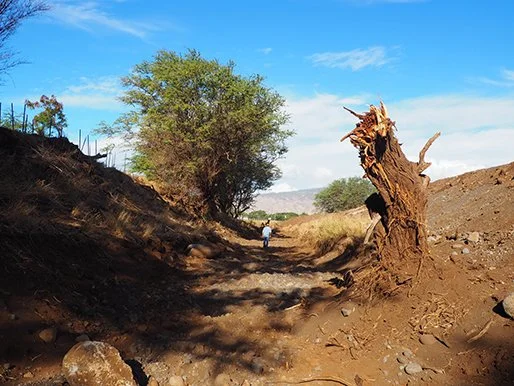Background: The Pulehu Fire burned approximately 5,700 acres owned by Mahi Pono (3,000 acres), Haleakala Ranch (2,500 acres) and Kaonoulu Ranch (200 acres). As working agricultural and grazed lands, landowner interests and objectives are key considerations in fire mitigation recommendations.
Recommended Practices:
Revegetation: It is recommended that the entire burn area be reseeded, with the areas along the gulches given the highest priority for treatment.
Grasses are the most effective plants for large scale, landscape level soil stabilization. After considering many factors, buffelgrass (5 lbs/acre Pure Live Seed) is the principal recommended species, as it is well-adapted to the site, is an excellent soil stabilizer and existed in a near monoculture on this landscape prior to the fire and is readily available commercially. Buffelgrass has deep roots that anchor the soil and forms a quick canopy and abundant litter that protects the soil surface from raindrop impact and sheet, rill, and wind erosion. Buffelgrass also provides valuable livestock forage, which is important to all three landowners affected by this fire.
Native species such as pili grass (Heteropogon contortus) could be incorporated into the reseeding plan based on availability and appropriateness to the site in areas not actively grazed by livestock.
Aerial broadcast seeding is the preferred method for the entire burned area, with hydroseeding as an option for the more severely burned areas depending on location and access. Temporary irrigation water would help germinate the seeds along the gulches more rapidly.Fencing: Fencing the burned area is the highest priority and critical to create a favorable environment for the existing grasses to resprout and recover and for newly broadcast seed to germinate and establish without being subject to intense grazing pressure from axis deer. Fences must be woven wire with one barbed wire strand placed along the bottom and be at least 6 feet tall. The fencing alignment will be coordinated with the existing landowners and their business operations. The estimated length of fencing need is approximately 14 miles.
Firebreaks: Revegetation and reestablishment of the burned grass is of critical importance to protecting the soil and preserving water quality, and the installation of accompanying firebreaks is a crucial supporting practice for mitigating the associated wildfire risk with a healthy grass-dominated plant community in a dry, windy area. This is true for both native and non-native grasses.
Gulches & Tree Removal: In general, the bottom of gulches within the Pulehu fire unit were not burned, and the vegetation appears to be intact. Furthermore, prior land management, particularly in the Mahi Pono section, often included piling of rocks and soil along the top edges of gulches. For these reasons, mulching as a soil stabilization measure is not considered a high priority practice in the Pulehu burn unit.
NRCS recommends burned trees that have fallen into the gulches be removed and has identified the areas where tree removal will be needed.Natural Drainages (Gulches) – Berm Repair: During a site visit, a network of previously established earth berms were observed at the top banks of principal natural drainages i.e. gulches. These were probably created as rocks and soil for land smoothing were removed from cultivated fields. In some locations, small sections of the earth embankments have been removed. NRCS recommends that in these locations totaling approximately 650 linear feet that the berms be restored to control storm surface water flow into gulches.
Natural Drainages (Gulches) – Rock Barriers: There are several tributaries identified that NRCS recommends placing temporary rock barriers at the bottom channel to catch sediment and debris. The concept here is to provide short-term sediment trapping infrastructure to capture a portion of storm water sediments that are likely to be associated with initial post-fire rainstorm events.
Sediment Removal: During the fire, several dozers were used to cut firebreaks. In the process of establishing the firebreaks, the dozers crossed Keahaiwi Gulch and pushed earthfill into the channel. NRCS recommends that this earthfill be removed from the channel and the channel restored to match the existing channel cross section.
In other areas, storm events prior to the Pulehu Fire incident resulted in sediment laden runoff that deposited significant quantities of sediment in gulches and urban drainage channels, and also led to water and sediment inundation in developed areas of Kihei. As drainage channels pass through lower elevations and approach the ocean, water runoff velocity will slow and sediment will be deposited. This is particularly noticeable where primary road bridges cross drainages near Kihei, and where the channels are considerably wider both upstream and downstream of the bridges. NRCS recommends that existing sediment at the bridge locations identified be removed.
Please see the Pulehu Damage Survey Response Report for more information.
Pulehu EWP Project Status:
Landowner agreements have been executed. The fencing and firebreak plan has been updated with NRCS. Aerial seeding has been removed from the project scope as plants are recovering. Some additional seeding may be needed in focused areas where the burn scar is still evident and recovery has been slower.
Kulanihakoi Sediment Removal: contract executed in September 2024 to remove significant sedimentation in Kulanihakoi Gulch that posed flood risks to the South Maui community. Project work completed in January 2025.
Before project: sedimentation beneath the bridge
After project: sedimentation cleared below the bridge
Multiple service contracts in various stages of execution; bonding costs and issues have created delays.
Work on Haleakala Ranch land: Fencing has been completed in Waiahono and the 2-3 paddock. Installation of firebreaks and fencing at the top of Ohukai Road in Kihei are in progress.
Approximately 5,000 cubic yards of sediment was removed from Waiakoa Gulch immediately upstream from Piilani Highway in October 2025. Sediment removal from a small gully on Mahi Pono property targeted for 2026.
Work on Kaonoulu Ranch land: Materials have been ordered. Fencing to begin soon. Fuel breaks have been installed.
Work on Mahi Pono property: Fuel and firebreaks have been completed. Installation of fencing is in progress.
Waiakoa Gulch sediment removal, October 2025
Fencing work on Haleakala Ranch, May 2025. Fencing helps to protect recovering areas from feral ungulates that can cause significant damage to new vegetation and landscapes.
Updated: November 19, 2025









